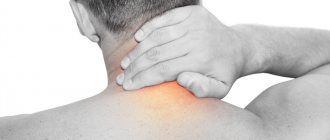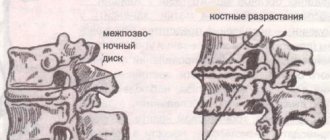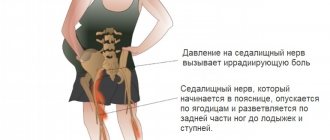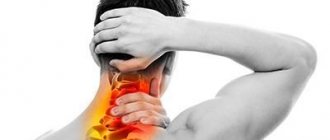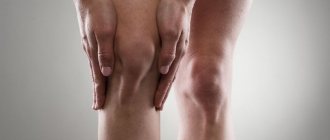For many women, osteochondrosis during pregnancy causes a lot of unpleasant sensations. And with severe damage to the structure of the intervertebral discs in the lumbar and lumbosacral spine, spontaneous abortion or premature birth may occur. In some cases, disruption of the process of innervation of the pelvic organs leads to intrauterine fetal death.
As you can see, osteochondrosis during pregnancy is not a harmless problem, which is only expressed in the fact that there is quite a strong pain syndrome. One can say even more, if measures are not taken for timely effective treatment, then after pregnancy a young woman may remain disabled due to the total destruction of cartilaginous intervertebral discs and degeneration of the vertebral bodies.
This article describes how osteochondrosis can be safely treated during pregnancy using manual therapy methods. Here you can learn about the common causes of the development of this pathology during pregnancy.
If you live in Moscow and are in an “interesting situation,” you can sign up for a free initial consultation with a chiropractor in our clinic. The doctor will talk about how you can prevent and treat osteochondrosis during pregnancy without harming the health of the expectant mother and her baby.
Causes of osteochondrosis of the cervical spine during pregnancy
Cervical osteochondrosis during pregnancy is much more common than one might think. It would seem that the entire main load from the growing fetus falls on the lumbar and lumbosacral spine. But in fact, during pregnancy, different factors act simultaneously on the process of spinal destruction.
Osteochondrosis of the cervical spine during pregnancy can be provoked by the following negative factors:
- hormonal changes in the body lead to the fact that cartilage tissue begins to actively deteriorate (this is necessary to fully prepare the body for the process of natural childbirth);
- leaching of calcium minerals from the structure of bone tissue and the phenomenon of primary osteoporosis with the formation of cracks and their filling with calcifications;
- deficiency of certain vitamins does not allow restoration of the structure of cartilage tissue;
- mechanical pressure of the growing uterus leads to deformation of the vascular bed;
- an increase in the volume of circulating blood depletes it of formed elements, which negatively affects the trophism of the body tissues of the expectant mother;
- the increasing load on the muscular frame of the back blocks the normal diffuse nutrition of the cartilage tissue of the fibrous ring of the intervertebral disc.
Risk factors are also important for the formation of osteochondrosis during pregnancy. First of all, this is a deformation of the spinal column and divergence of the femoral bones in the acetabulum, due to which the position of the foot may change. Such skeletal deformations begin to occur later than 30 weeks of pregnancy. Mandatory assistance from an osteopath and chiropractor is required. Excessive divergence of the pubic bones can lead to rupture of the symphysis and this will cause disability in the subsequent period.
Osteochondrosis of the cervical spine during pregnancy (as well as other sections) can develop due to gross violations of the doctor’s recommendations:
- non-compliance with the recommended diet;
- improper organization of work and sleeping space;
- carrying heavy objects;
- refusal to use a prenatal bandage;
- wearing uncomfortable high-heeled shoes;
- excess weight gain;
- maintaining a sedentary lifestyle;
- change in posture due to a growing belly.
The elimination of these negative factors allows for active prevention of degeneration and destruction of intervertebral discs during pregnancy. If problems have already arisen, you should seek help from a specialist. Treatment of osteochondrosis using manual therapy techniques is possible only after 30 weeks.
Thoracic osteochondrosis during pregnancy
The rarest localization is thoracic osteochondrosis during pregnancy, since the increasing vital volume of the lungs stabilizes the position of the chest and does not lead to displacement of the vertebral bodies.
The main reason for the development of thoracic osteochondrosis during pregnancy is the high position of the uterine fundus. In this situation, a displacement of the internal organs of the abdominal cavity occurs and an imbalance of intracavitary pressure occurs. Due to its increase, the diaphragm protrudes into the chest. Due to compression of the pleura, destructive processes begin in the intervertebral discs.
Symptoms of thoracic osteochondrosis during pregnancy:
- feeling of lack of air and inability to breathe deeply;
- pale or bluish coloration of the lips, fingertips and eyelids;
- dizziness, muscle weakness, increased sweating;
- pain in the thoracic spine (between the shoulder blades);
- increased pain when trying to turn the body.
Treatment of thoracic osteochondrosis during pregnancy consists of using a special support corset, exercises and wearing a prenatal bandage on an ongoing basis. After 30 weeks of pregnancy, it is possible to use manual therapy, which, with the right approach, can prepare a woman for the process of natural childbirth.
Osteochondrosis of the lumbar spine during pregnancy
Lumbar osteochondrosis during pregnancy is the most common localization of the pathological process of destruction and degeneration of the cartilage tissue of the intervertebral discs. It must be taken into account that as the body of the uterus grows, the physiological curve in the lumbar region gradually smoothes out. In this case, the center of gravity shifts to the sacrum, which may begin to diverge.
Poor posture leads to deformation of the entire shock-absorbing capacity of the spinal column. At 28–32 weeks, deformation of the hip joints begins due to the divergence of the pubic bones. A change in the angle of the femoral head in the articular cavity of the acetabulum leads to a change in the position of the foot. It begins to flatten and a gradual transfer of load distribution occurs.
All this has an extremely negative impact on the condition of the intervertebral discs. the pressure of a multiply grown uterus leads to a total disruption of the blood supply to the soft tissues of the lumbar and lumbosacral spine. If a woman has not prepared for the process of bearing a pregnancy, then her back muscles may not be able to cope with such physical stress. Therefore, it is extremely important to constantly wear a prenatal bandage from mid-pregnancy. And from about 30 weeks of pregnancy, you should conduct special classes with a chiropractor who will help strengthen your muscles and prepare safely for childbirth.
Osteochondrosis of the lumbar region can be treated during pregnancy with the help of gymnastics and massage. And from about 30 weeks, reflexology, osteopathy and kinesiotherapy are indicated. An integrated approach will allow you to quickly and safely defeat this dangerous disease.
Possible complications
Osteochondrosis of the lumbar region during pregnancy can harm not only the expectant mother, but also the fetus. What are the risks for an unborn child if his mother has this disease? A pregnant woman experiences severe pain in the lower back and legs, which limits movement. Besides:
- Blood circulation in the lower back is impaired, which leads to impaired blood flow in the legs.
- Blood pressure increases.
- The level of hemoglobin decreases, which leads to the development of anemia and fetal hypoxia.
- The risk of vascular and heart pathologies increases.
- There is a risk of miscarriage in the early stages.
- Premature birth is possible in the third trimester due to severe pain that provokes uterine tone.
Also, osteochondrosis can lead to intervertebral hernia and damage to the spinal cord.
Symptoms of exacerbation of osteochondrosis during pregnancy
Exacerbation of osteochondrosis during pregnancy is possible if, before conceiving a baby, a woman already had signs of degenerative changes in the intervertebral discs of the spine. and this is a very important point for those representatives of the fair sex who are now at the stage of planning a pregnancy. The fact is that exacerbation of osteochondrosis before childbirth can be prevented. To do this, you just need to undergo a comprehensive examination.
If osteochondrosis is detected, then before the baby is conceived, you need to undergo a full course of manual therapy in order to restore the intervertebral discs. After this, the chiropractor will give all the necessary recommendations for managing pregnancy. This will eliminate the possibility of developing an exacerbation of the chronic process of destruction of the fibrous ring of the intervertebral disc.
Clinical symptoms of osteochondrosis during pregnancy can manifest themselves in the form of the following signs:
- pain in the area of local damage and inflammation;
- muscle tension at the site of disc damage;
- limited mobility and feeling of stiffness;
- numbness of the upper or lower extremities;
- convulsions and sensation of crawling in certain areas of the body;
- striped pain spreading along the back or side of the thigh and lower leg.
When conducting diagnostics, the doctor performs a series of functional tests that show the localization of osteochondrosis and the degree of damage to the intervertebral disc. X-rays and MRIs are not recommended during pregnancy due to the unsafety of these examinations for the growing fetus.
Diagnosis of osteochondrosis in pregnant women
If one or more symptoms from the list above occur, a woman should consult a doctor. The main diagnostic method for pregnant women is examination. The doctor talks with the patient, palpates the lower back and coccyx, and in a standing position looks to see if the gluteal folds are symmetrical and if there is a distortion of the sacral Michaelis diamond.
When examining pregnant women, hardware diagnostics (X-ray, CT, MRI) are contraindicated. To make a diagnosis, the doctor writes out a referral only for blood and urine tests, and also refers the patient to specialized specialists: a neurologist, an orthopedist, a surgeon and others.
How to treat osteochondrosis during pregnancy?
When carrying a baby, you can take pharmacological medications only as prescribed by a doctor. self-treatment can lead to dire consequences, including the threat of termination of pregnancy or the development of congenital deformities of the fetus. Therefore, it is impossible to treat osteochondrosis during pregnancy at home.
It is worth consulting a doctor who knows how to treat osteochondrosis during pregnancy and what remedies will be safe for the health of the baby and the expectant mother. Before treating cervical osteochondrosis during pregnancy, you need to adjust your daily routine if possible. It is important to understand that this disease is most often associated with prolonged static tension in the muscles of the collar zone. You need to take regular breaks from work. During rest, you can perform special exercises for the muscles of the neck and collar area.
If you are more than 30 weeks pregnant, you can visit a free consultation with a chiropractor at our clinic. The doctor will tell you how to treat cervical osteochondrosis during pregnancy and what techniques will help eliminate all the negative symptoms of this pathology.
The use of pharmacological agents in the form of external ointments is not recommended. The fact is that these drugs in most cases are based on non-steroidal anti-inflammatory drugs. And they are strictly contraindicated during pregnancy, as they can provoke uterine bleeding, placental abruption and premature abortion. external application of the ointment leads to the fact that the active substance penetrates into the thickness of the epidermis and is absorbed into the bloodstream there. Therefore, external use is also unacceptable for the use of drugs.
Symptoms
Signs of the disease do not appear immediately - the initial stage in almost everyone is either asymptomatic, or makes itself felt only by rare unpleasant pulling sensations. Pain appears only when turning or bending unsuccessfully, or when lifting something heavy. As a rule, it is possible to recognize lumbar osteochondrosis during gestation only at the second stage.
Symptoms by which the disease can be identified in an expectant mother:
- Lower back pain and limitation of motor activity associated with shooting pain when turning or bending. The pain syndrome radiates to the leg from the side of the pinched nerve root.
- Cauda equina syndrome is a feeling that the legs are numb when the nerve bundle is pinched at the level of the first vertebra in the lumbar area.
- Increased sweating, in places where there is damage to the vertebrae or pinched nerves, the pregnant woman feels a tingling and burning sensation.
- There may be problems with urination.
- Spasms of the back muscles occur during exacerbation of lumbar osteochondrosis, which limits the woman’s motor activity.
- Increased pain when coughing and sneezing, and it radiates to the thighs, buttocks and calf muscles.
On a note. Relief comes when taking a horizontal position. If you consult a doctor at this stage, you can slow down the process and significantly improve the condition and quality of life of the pregnant woman without resorting to strong drugs.
Treatment methods for osteochondrosis during pregnancy: what to do?
Treatment for osteochondrosis during pregnancy should always begin with consultation with a specialist. The doctor will take a medical history and examination, identifying potential causes of this disease. Then all the necessary recommendations will be given, which, if carefully followed, will eliminate the pain syndrome without the use of medications.
Starting from the 30th week, treatment of cervical osteochondrosis during pregnancy can be carried out using traction using a special loop. This procedure quickly restores impaired cerebral blood supply and eliminates all negative consequences. If there are contraindications for traction of the spine with osteochondrosis during pregnancy, osteopathy and massage, reflexology and kinesiotherapy are used.
The first thing to do if you have osteochondrosis during pregnancy is to seek qualified medical help. Self-treatment using various ointments, gels, heating and other similar techniques is not permissible.
We invite you to a free consultation at our manual therapy clinic. During your first appointment, your doctor will tell you about all the possibilities and prospects for treating osteochondrosis during pregnancy.

